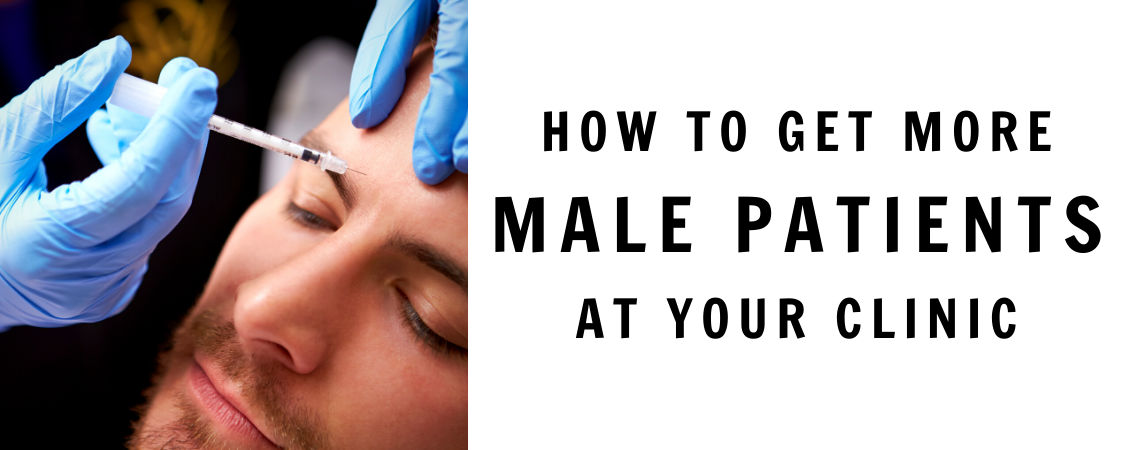
Reading time: approximately 4-5 minutes
We’re sure you’d agree that, in this day and age, beauty treatments are definitely not just for women.
There’s been a societal shift in recent years, with male attitudes towards personal care and grooming becoming more positive, and more men embracing waxing, facials and even aesthetic procedures. However, we’ve still got a long way to go before most aesthetic clinics see a 50/50 split between male and female patients. While some men may be more open to the idea of visiting an aesthetic or skin clinic, these treatments are still often viewed as “for women only” and there is also sometimes an underlying fear of being made to look “feminine”.
Of course, as aesthetic practitioners, we know that treatments such as botulinum toxin and dermal fillers can be just as beneficial to men as they are to women. In fact, rather than making men look feminine, they can actually do exactly the opposite, adding definition to jawlines for a more masculine profile, as well as reducing lines and wrinkles to give a more refreshed, youthful result.
But if a lot of men still associate aesthetic clinics with women, how do we actually get them through the door?
It all comes down to marketing…
Spell it out
Think about your current marketing activities. Whatever you’re doing at the moment, whether it’s social media posts, website, print advertising, or even posters and signage outside your clinic - does any of it make it clear that you treat men too?
If nothing in your current marketing shows that men are welcome, potential male clients may simply assume that your clinic is a space for women only. Of course, this can be easily rectified by pivoting on your messaging to show that the treatments you offer are available for both men and women. If you already have a small number of male patients, consider sharing their before and after photos (with permission of course) on your social media, as well as posting about the various treatments you offer that could be beneficial to men. You could even create a men’s section on your website that goes into more detail about these treatments.
What does your image say?
Following on from your messaging, you may also want to think about the overall image of your clinic. What’s your colour scheme? What does your branding say about you? Many clinics embrace neutral colours and minimalistic design, in keeping with a clinical, medical setting, and this tends to appeal to both men and women. However, if your clinic branding leans a bit more towards the feminine, this may be alienating potential male patients. To put it bluntly, men are probably not going to be queueing around the block to visit a clinic where everything is pink, fluffy and covered in glitter!
Of course, if you’ve spent time establishing a brand and this aesthetic appeals to your current clientele, the last thing you’ll want to do is completely change it. But perhaps there are other steps that you can take to show that men are welcome - additional signage (as mentioned above) outside the clinic, or even a dedicated “Men’s Treatment Day” once a month.
Spread the word
Word of mouth continues to be an extremely strong tool for marketing within aesthetics, as men and women are far more likely to follow the recommendation of a trusted source. If you can encourage your female clients to recommend your clinic to their male partners, relatives and friends, perhaps via a referral scheme, this could be a great way of encouraging men through the door. Always keep in mind advertising regulations and guidelines when it comes to promotions, offers and discounts.
Get to know your existing patients
If you do already have some male patients, do a bit of patient research. Are they repeat patients? Did they come in for a one-off treatment and never come back? Why? A survey can be a great way to find out more about the male patients you do have, including what brought them to your clinic, what they like and what they want to see more of. This information can then be used to shape your marketing moving forward.
Tailor your emails
If you currently utilise email marketing, think about how this can be tailored to appeal more to male patients. Rather than sending out one mass email to everyone on your mailing list, try segmenting the list into male patients and female patients, then composing separate emails for each using different messaging and focusing on the different treatments they are more likely to be interested in. As above, the response to these emails (click through rate, bookings etc) can help to shape further marketing activities in the future.
Go where the men are
Still struggling? Offline advertising can help to attract male patients too! Think about where men are most likely to be in your community, and (if allowed) drop off some leaflets or a poster. Gyms can be a great place to advertise your services, as can barber shops. In fact, for mobile aesthetic practitioners, barbers could be an untapped resource. Many practitioners offer one-off clinic days in beauty and hair salons, but this is not so common in barber’s. If your local barber shop has a suitable room or space for aesthetic treatments, why not reach out and see if they’d be open to you offering treatments there? This approach may appeal to first-time male patients in particular, as a barber shop (that probably already has a very “male” feel to it) will seem less intimidating than a clinic.
